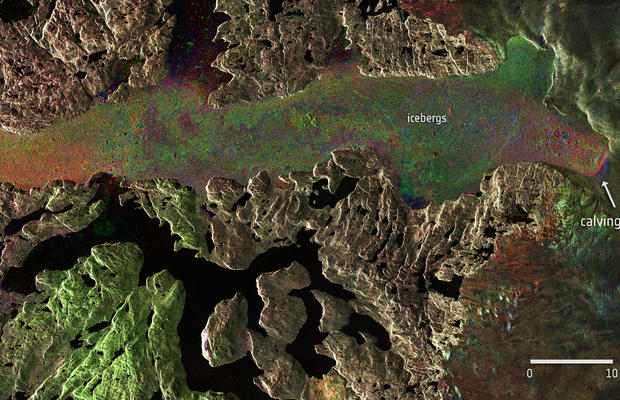Greenland glacier loses chunk the size of Manhattan
Satellite images show that the world's fastest moving glacier lost a piece of ice measuring nearly 5 square miles over two days. Scientists say it is one of the most significant calving events on record.
Radar images of the Jakobshavn glacier in Greenland, taken from the European Space Agency's (ESA) Sentinel-1A and Sentinel-2A weather satellites between July 27 and Aug. 19, show the massive glacier advancing westward before its front rapidly retreated as a huge chunk fell off it front, sometime between Aug. 14 and Aug. 16.
"Just a few weeks ago, we witnessed the spectacular calving event of Jakobshavn in Greenland which removed 12 square kilometers (4.6 square miles) of ice in one day and pushed the calving front of that glacier further back than ever before," Eric Rignot, a glaciologist at the University of California, Irvine and NASA's Jet Propulsion Laboratory, told reporters Wednesday. "The glacier keeps retreating rapidly into a deep canyon.... We are likely to see more of those calving events in the coming years as the glacier retreats into deeper ice."
Rignot said he was personally "in awe" of the retreat.
"We've never seen something like this on that scale before. What's happening on Jakobshavn is extremely important and relevant to other pieces of Greenland," he said. "This big piece of ice that disappeared a few weeks ago is not going to be replaced easily by some weird events over the winter. We are seeing a continual retreat of this ice front."
The ESA estimates that the ice is about 1,400 meters (4,600 feet) thick, meaning that the piece lost has a volume of about 17.5 cubic km, which is enough to cover the island of Manhattan in a layer of ice almost 1,000 feet deep.
Similar events have taken place before, for example in 2011 and in July 2010, but the area of this calving is nearly twice the size of that event.
Greenland is the world's second largest ice body, and melting of its ice sheet contributes about 40 percent of current sea level rise. Jakobshavn glacier drains 6.5 percent of the Greenland ice sheet and produces and tenth of its icebergs -- totaling 35 million tons of ice calved each year.
According to a wide-ranging new study published earlier this month in the Journal of Glaciology by the World Glacier Monitoring Service, in the first part of the 21st century, glaciers are melting faster than at any point in the last 165 years -- and possibly any point in recorded history.
"Ice sheets are contributing to sea level rise sooner and more significantly than anticipated," Rignot said. "About one-third of global sea level rise is due to the melting of ice sheets into the ocean. We know with future warming, ice sheets will dominate sea level rise because they hold a much larger volume of ice than glaciers and ice caps."
